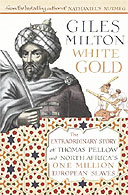When Morocco ruled the waves
Giles Milton uncovers a striking story of the 18th-century white slave trade, but fails to place it in a wider context in White Gold
 Buy White Gold at Amazon.co.uk
Buy White Gold at Amazon.co.uk White Gold
by Giles Milton
Hodder & Stoughton £18.99, pp316
Giles Milton's lively account of the north African white slave trade in the 17th and 18th centuries includes a description of an attack on a Cornish fishing village by a fleet of Islamic corsairs. The warriors, wielding scimitars, stream into the cobbled streets and force their way into cottages, taverns and churches to seize the villagers and carry them off to the Moroccan port of Salé to be sold as slaves. It is a shocking event and one that challenges the dominant historical narrative of England's proud seafaring past.
Milton has made his name by retrieving such lost episodes and writing them back into the history books. In Nathaniel's Nutmeg, he examined the role of Nathaniel Courthope, a lieutenant of the East India Company, in the 17th-century conflict between England and the Netherlands for control of the spice islands of south east Asia. And in Samurai William, he recounted the life of William Adams, an English sailor who washed up on the shores of Japan in 1600 and was responsible for opening relations between the two countries.
In White Gold, as in the earlier books, Milton focuses his historical disquisitions through the extraordinary story of one protagonist. Thomas Pellow was just 11 when, in the summer of 1715, he was seized from a Cornish cargo vessel in the Atlantic and sold as a slave to Sultan Moulay Ismail in the Moroccan city of Meknes.
Yet it is Moulay Ismail, not Pellow, who emerges as the most compelling character in the book. A brutal but quixotic ruler, he was a dandy given to indicating his mood by the colour of his clothes. 'Green is his darling colour, which is a good omen for those who come to him,' wrote one of the European padres stationed in Meknes. 'When he wears yellow, all men quake and avoid his presence; for that is the colour he puts on when he designs his bloody executions.'
Moulay Ismail was also a fervent follower of Koranic teaching. Devotion to Islam was greatly admired in Morocco, but it was, apparently, the source of growing consternation in the Christian West. 'It curbs none of his passions and justifies all his enormities,' wrote the same European padre, '[and] sanctifies the cruelties he exercises towards the Christians and the Moors.'
Milton boldly claims that Moulay Ismail provoked 'a growing backlash against Islam in almost every nation in Europe'. But this goes largely uncorroborated since he never actually investigates the state of relations between the Christian and Muslim worlds during the period.
This inattention to a broader historical context is characteristic of the book. Milton neither compares the North African trade in white slaves to the black slave trade, nor examines the disjunction between English ships' vulnerability to capture by corsairs and the standard orthodoxy of English maritime might. He prefers to scrutinise this loose strand of history than weave it back into the larger fabric.
Drawing on letters, journals and manuscripts written by the slaves, as well as European padres and ambassadors, Milton has produced a disturbing account of the barbaric splendour of the imperial Moroccan court, which he brings to life with considerable panache. For all its omissions, White Gold is an engrossing, expertly told story.
Thanks for being part of "PoliticalForum" at Google Groups.
For options & help see http://groups.google.com/group/PoliticalForum
* Visit our other community at http://www.PoliticalForum.com/
* It's active and moderated. Register and vote in our polls.
* Read the latest breaking news, and more.
No comments:
Post a Comment